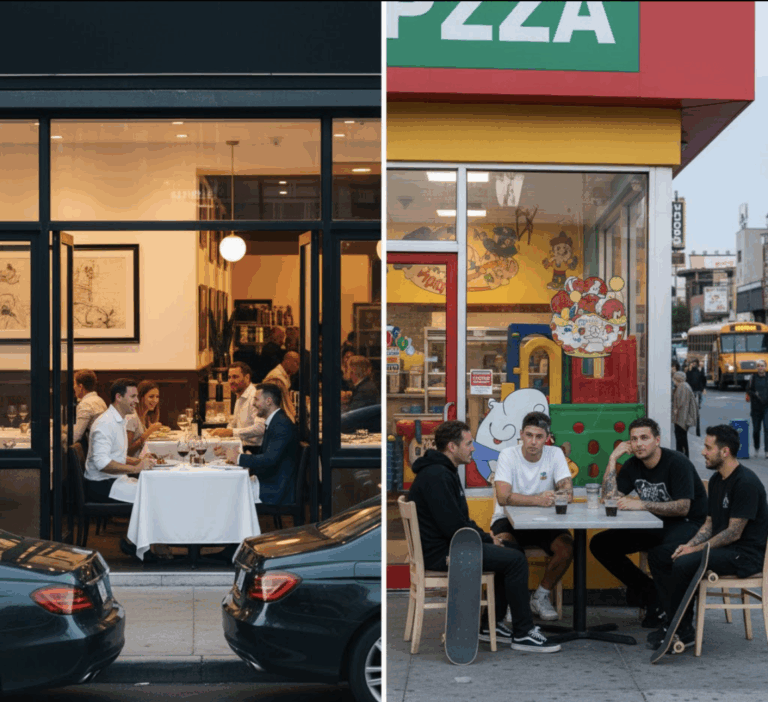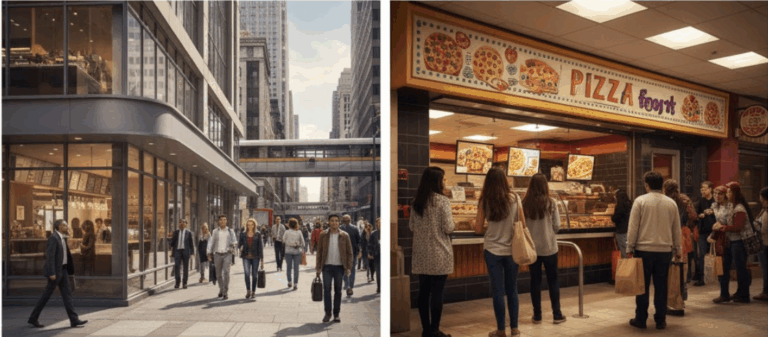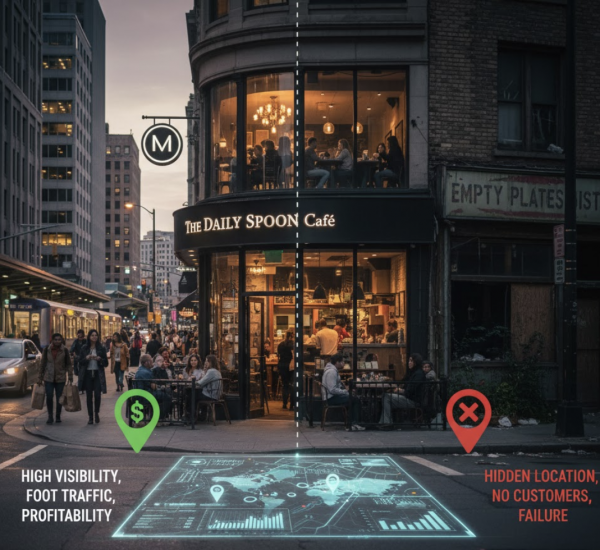Every year, thousands of restaurants fail within their first few years of operation. A major reason for this is poor location decisions.
You might have the perfect menu and an exceptional team for your restaurant. But if you select the wrong location, all those efforts can quickly fade away.
Location is not just a pin on the map. It determines who discovers your brand and how often they visit. It sets the foundation for your restaurant’s growth and profitability.
In this guide, we’ll discuss in detail the importance of location for restaurant success and what factors you should consider before signing a lease.
Let’s get started.
Why Location Is Important for Restaurant Success
Before locking in a lease or scouting potential spaces, it’s essential to understand exactly how location impacts performance.
Let’s explore the core reasons why choosing the right location can make or break your restaurant:
Maximize Visibility and Increase Foot Traffic
Visibility is a restaurant’s silent marketing tool. The more people see your restaurant while commuting or running errands, the more likely they are to stop in.
If you have a restaurant on a busy street or near a popular retail hub, it essentially advertises itself. For example, a café near a train station or a fast-casual spot by a shopping center will naturally draw in more customers than one hidden in a back alley.
But if your restaurant is at a hidden location, it will struggle to capture attention. Even online visibility, such as accurate listings on Google Maps, complements your physical location and ensures that potential customers can find you.
Attract Your Ideal Customers
Your restaurant’s location directly influences who walks through your doors. Fine dining succeeds in upscale neighborhoods with higher disposable incomes. Similarly, family-friendly restaurants perform better in suburban areas where households and schools are nearby.
When your location aligns with your target audience, you naturally build repeat visits and long-term loyalty.
Stand Out from the Competition
The restaurant industry is highly competitive. If you select a location without analyzing nearby players, it can put your business at a disadvantage. For example, opening another pizza restaurant in an area already filled with similar options reduces your chances of success.
However, if you carefully study the local market, you can identify gaps and opportunities. If a neighborhood lacks a particular cuisine or dining concept, your restaurant can capture untapped demand and quickly build a loyal customer base.
Enhance Operational Efficiency
Operational efficiency also depends heavily on location. If your restaurant is well-placed, it is easier for staff to reach and suppliers to deliver. Customers can also access it easily.
Simple details such as parking availability and traffic flow also impact daily operations. For instance, if your restaurant is on a busy road but has difficult entry points, customers may avoid it.
Likewise, if suppliers face challenges in delivering ingredients on time, your kitchen may suffer delays. A convenient and accessible location facilitates smoother workflows, ultimately enhancing customer satisfaction.

5 Key Factors to Consider When Choosing the Perfect Restaurant Site Location
To choose the right location, consider these key variables that affect visibility, customer alignment, and cost-effectiveness.
Focus on Demographics
First of all, ask yourself who are your customers?
Look for things like their age groups, household income, and lifestyle habits in the area. It will help you match your restaurant concept with local demand.
Analyze the Competitors Around You
Then check what other restaurants are doing nearby. Specifically, their pricing and menu variety can reveal opportunities or threats. You need to complement or differentiate rather than duplicate.
Make Accessibility a Priority
It is also important to look for areas with parking and public transport options, as customers prefer restaurants they can reach without hassle.
Stay Compliant with Local Regulations
Every city has zoning laws and health codes in place. Noncompliance can result in fines or forced closures. So, always confirm that your chosen site aligns with local rules before moving forward.
Balance Costs with Location Potential
High-rent areas attract larger crowds but also increase financial risk. So, calculate beforehand how much revenue your restaurant must generate to justify rent and other expenses. It is better to strive for long-term sustainability rather than short-term gains.
What Type of Location is Ideal for your Restaurant Success?
To truly succeed, you need a strategy that matches your restaurant’s concept with the types of locations that generate the highest returns. This means going beyond demographics and visibility to understand where your specific offering can thrive.
Below are some of the most profitable types of sites to consider for long-term success:
Urban Centers
Urban locations offer high foot traffic and steady business lunch crowds. They are perfect for fast-casual spots, trendy cafés, and innovative dining experiences.
Although competition is strong, a strategically positioned restaurant like a sushi bar near office towers or a coffee shop on a busy pedestrian street can attract large volumes of customers.
Shopping Malls and Retail Districts
Retail areas provide built-in traffic from shoppers, as families and groups often look for convenient dining options while out shopping.
For instance, a pizza place tucked into a mall food court or a café along a popular retail strip can attract consistent footfall throughout the day.
Residential Neighborhoods
Neighborhood restaurants create loyalty and repeat business. These spots are perfect for family-friendly cafes or casual dining. While foot traffic may be lower than in commercial areas, the proximity to households creates consistent demand.
Near Universities and Office Buildings
College campuses and office districts are also prime areas for quick-service restaurants. Students seeking affordable meals and professionals needing convenience make these locations profitable. These spots experience high weekday demand and can become community favorites.

Mapchise – Your Data-Driven Partner for Restaurant Site Selection
Choosing the right restaurant location can be challenging, but Mapchise simplifies the process with restaurant-focused intelligence. It combines AI-powered insights, competitor tracking, and customer data to guide smarter site selection.
Our platform features like Customer Explorer, White Space Analysis, and Revenue Attribution that highlight high-potential areas for growth.
For multi-location brands and international expansions, Mapchise provides a data-driven solution to help your restaurant thrive in the right location.
Conclusion
In a nutshell, restaurant success starts with location. The wrong site can drain your resources, while the right one fuels loyalty and long-term growth.
Before committing to a lease, evaluate demographics, competitors, accessibility, and cost. Align your site with your brand strategy, and don’t leave it to chance.


